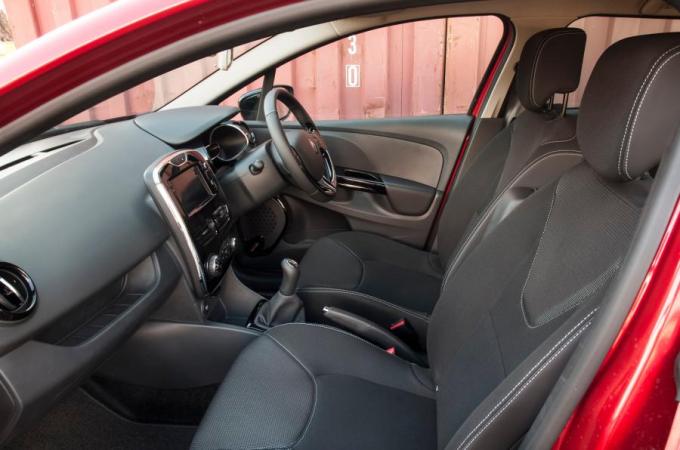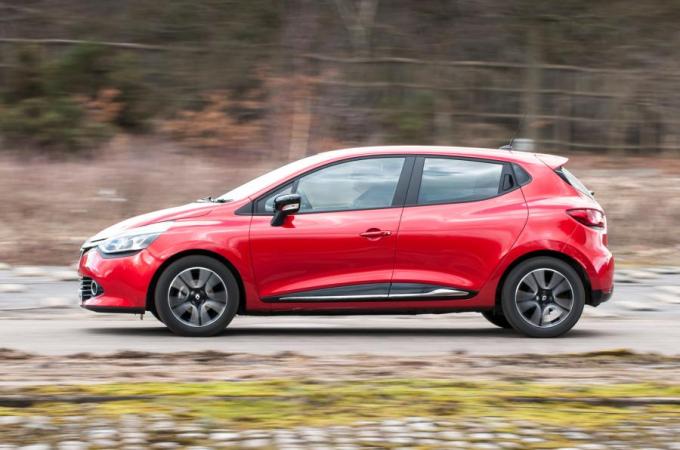Renault Clio Review

Ever since the late 1940s, Renault’s range has featured an unbroken line of interesting small cars, of which the Clio has been one of the most successful.
More than 12 million have found homes and, along the way, the Clio has found and enjoyed a youthful, vibrant image.
Earlier variants of the Clio deserved that rep, too: being agile, neatly designed, compact, engineered for some dynamism and intelligently marketed.
But – and Renault wasn’t alone in this – during the mid 2000s, when the Clio III arrived, some of that purity was lost. The Clio became bigger and heavier, and went searching – with honourable intent – for more refinement and class, growing up with its customers.
With the extra refinement it found, however, it lost something, as did several of its peers during the past decade. Out went a bit of what Renault used to dub the ‘va-va-voom’.
Which brings us to Clio IV: it’s notably leaner and cleaner than its predecessor. It is also offered with a range of engines, including a frugal 0.9-litre three-cylinder TCe petrol engine and a 1.5-litre dCi diesel, and a decent range of kit.
Question is, has all of that reintroduced some of the joie de vivre? Let’s find out.
First impression? The new Clio is bold, make no mistake. Even though it is sculpted to appear much more lithe than its immediate ancestor, it still looks like a Clio to us. Even, we suspect, were it not wearing a Renault diamond the size of a dinner plate on its nose.
There are differences in proportion, though. Renault has made quite a big play of the fact that the wheelbase is longer than on Clio III (by 14mm, up to 2589mm) but while this is likely to have an effect on handling, it doesn’t help place the wheels closer to each corner, because overall length is up by 30mm.
With that too, though, has come an increase in track, a more steeply raked windscreen and a much lower height: at 1448mm, the latest Clio’s roof sits some 45mm closer to the ground than a Clio III’s.
All of which leaves it looking more dynamic. Renault also reckons that, model for model, the new car is some 100kg lighter than the old one. The Clio III did, in fairness, carry easy pounds to lose, but even so, at this level 100kg is not an amount to be sniffed at.
The range of new engines in the Clio reflects that of its rivals, catering for most tastes and requirements. The entry-level engine is a basic 1.2-litre 16V petrol unit. A modern turbocharged 0.9-litre three-pot TCe petrol is also offered, as well as an 89bhp 1.5-litre dCi diesel.
All versions claim admirable levels of economy and efficiency, particularly if you choose the optional ECO derivatives of the diesel and TCe engines. These emit and consume less than the standard ones, although only by negligible amounts.

Inside the Clio there's a generous amount of space and the cabin is of a particularly good size. It offers 10 per cent, or a couple of inches, more legroom than you’ll find in the average small hatch, and an inch or so of ‘extra value’ headroom for back seat travellers.
For relatively large adult passengers, in the context of this class, that could make an important difference. We can get on fine with a digital speedo, and appreciate the good-sized indicators and fuel gauge.
There’s the usual quantity of cabin storage but no especially neat or clever packaging solutions. Having added interior space to the Clio with its basic proportions, Renault’s focus was clearly on injecting colour and life into the cabin, and successfully so.
The most conservative choice is a black fascia with black cloth seats, but its attractive sculptural instruments, complemented by lots of gloss black and chrome accenting, lends it an air of technical style and sophistication.
Consumer electronics are an obvious inspiration here, just as they were for the Ford Fiesta. The difference is that, while the Ford’s cabin could have been penned by graduates from Nokia and Motorola, the Renault’s is one of the converged touchscreen design generation, with clearer nods to the likes of Apple, Samsung and HTC.
In terms of function, however, Renault’s R-link system needs some refinement. Postcode entry is still woefully limited, while map graphics on the satellite-navigation system look like they’re from a 1990’s games console, not a contemporary mass-market hatchback.
Material quality levels are fine, but again they don’t quite match that level of ambition. Most of the Clio’s background cabin plastics are ordinary in their look and feel. One or two loose, creaky trims even serve to remind us of Renault’s chequered track record on fit and finish.
There’s also a certain lack of attention to ergonomic detail. The engine start-stop button’s on the wrong side of the centre stack for right-hand drive, for example, and the cruise control button is in an unintuitive position by the handbrake.
Both peculiarities will be familiar to Renault owners, but on such an important car where progress has been made in other directions, this feels like a missed opportunity to remedy them.
There are three engine choices for the Clio. Buyers can pick from a basic 74bhp 1.2-litre, four-cylinder petrol engine, a more powerful turbocharged three-cylinder TCe petrol or an 89bhp 1.5-litre turbodiesel.
The mid-range engine option is a TCe unit, the conceit being that you’re getting 1.4-litre performance with greatly reduced fuel consumption, but that’s potentially a little misleading. We have, after all, tested other superminis of a similar displacement that are both faster and more efficient.
Nevertheless, it’s a good engine. Quiet, refined and responsive, its light-pressure delivery suits the Renault right down to the ground. The engine only really feels turbocharged at very low revs, otherwise it pulls cleanly and with stoutness through the mid-range while holding onto its power at high revs. it's also particularly smooth throughout. Ford’s EcoBoost triple may be more powerful, but it can’t match this Clio’s lack of noise and vibration.
The diesel engine is the more mature choice. It feels quicker than the figures suggest and it’s so quiet and refined that you’d struggle to tell it’s a diesel. Pleasantly, it’s also a tractable engine with a wide torque band, so you don’t have to work the gearbox as hard as you would in the petrol versions.
Admittedly the diesel does add 62kg to the kerb weight of the petrol model, leading to it feeling slightly less agile as a result. Those interested in maximum enjoyment should, consequently, stick to the zesty TCe option. There’s also a 1.2-litre engine carried over from the old model, producing 74bhp and 79lb ft of torque.
In all versions, the shift quality is light but well defined, and brake pedal feel is good. Overall, the Clio is an entirely pleasant device, peppy at times and quite suave at others, with the flexibility and polish to take mixed daily motoring duties in its stride, from motorway miles to cross-country backroads and the urban sprawl.

The Clio habitually ranks at the sharp end of the class in this regard. It has never been short on verve, even at the cheaper end of the model scale. But for the Ford Fiesta, you’d probably call it the finest example of the zesty, engaging European small hatch – the sort that the Japanese, Koreans and now the Chinese have been seeking to reproduce for the past 30 years.
But the new one sets higher standards than its immediate forebear right across the board, from compliance to high-speed stability to ultimate grip and amusement value. As a driving machine it’s the most multi-talented and complete supermini to come out of France in a long time: certainly since the Citroën DS3 in 2009, and probably for a lot longer.
The way the Clio segues from remarkable rolling comfort at one moment to slick and engaging handling accuracy the next, marks it out as a work of real class. It’s a calmer customer than the Fiesta; slightly softer of spring and less tautly damped, its low speed ride is very quiet but also more absorptive than the Ford’s.
This means that, at higher speeds, there’s a little more body movement in the Clio. But when that does materialise, and the road surface conspires to test the Renault’s mettle, excellent damper tuning and first-rate bump isolation combine to produce fluent body control and an unusually silken ride in one so small.
Indeed, on an urban test route the Renault feels well refined and able to glide over road defects in a manner more normally suited to a much larger car.
The steering wheel is quite large and it feels a little over-assisted at low speeds. But as you accelerate, so that power assistance ramps down. Ultimately, it allows a well paced, well weighted system to present that, although it isn’t very informative, does feel natural, if a little light in places.
Lean on the suspension and it firms up in trustworthy proportion, keeping control of the body and working the tyres just hard enough to produce plenty of grip and a consistent steering response.
An effective balance of dynamic virtues is what we look for in a good-handling hatchback, and the Clio’s balance of comfort and sporting brio is every bit as striking as its chic new clothes.
Renault has taken a deliberate step forwards with the new Clio; one that the car-buying public and rest of the car industry can’t fail to notice.
This pretty five-door is a statement of intent from a company keen to inject much-needed style, personality, usability and dynamism into its showrooms; it’s a blow landed on behalf of beleaguered Europe in a market where the far eastern powers have been making most of the gains of late. And it’s a resounding piece of work.
The Verdict:
Positives
- Distinctive styling
- Sophisticated ride and handling
- Good-sized, attractive cabin
Negatives
- Undistinguished performance
- Average interior finish
- Unremarkable economy from petrol models

